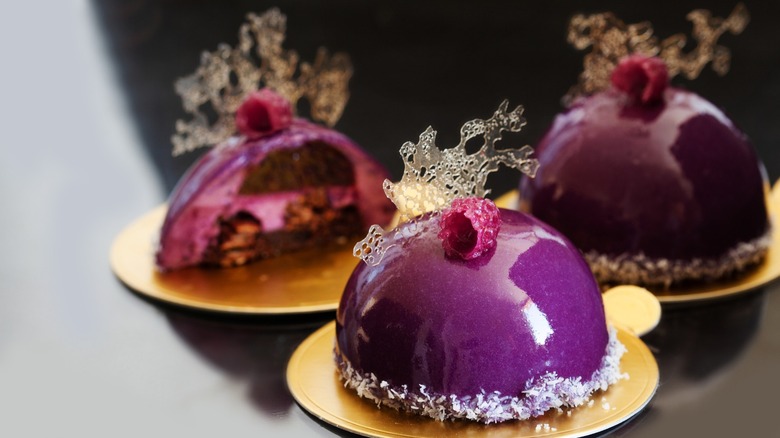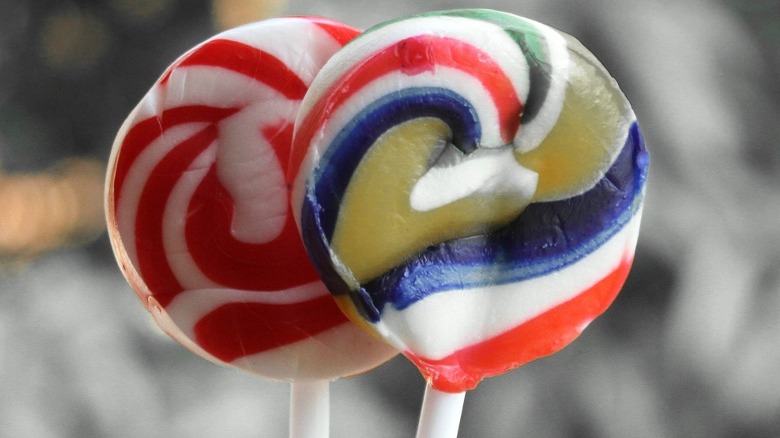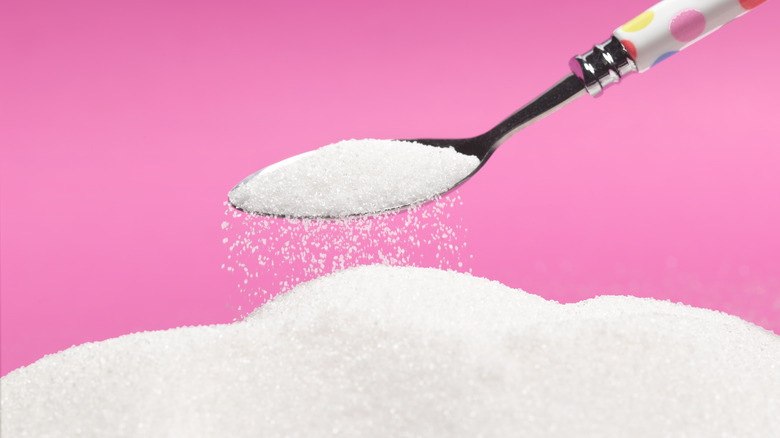Is Isomalt The Same As Sugar?
There are many known substitutions for sugar, but so far, none have been perfect. For example, corn syrup isn't an easy substitute for sugar because of its water content. Similarly, isomalt is more like aspartame, stevia, and sucralose. It is a low-calorie synthetic sugar substitute. But you probably haven't heard of isomalt when it comes to sweetening your tea or coffee. Instead, you've probably heard the word when it comes to making glass-like sugar art to decorate cakes and other sweet desserts.
The granulated sugar substitute has a higher resistance to humidity than sugar and does not crystallize when heated, which makes it the perfect choice for beautiful decorations. Given that it's also half the calories of sugar, why don't we all just switch to isomalt? It's not that simple. Isomalt doesn't dissolve in warm beverages or transform into luscious caramel. And that's because isomalt isn't at all the same as sugar when it comes to its physical properties.
What is isomalt?
Isomalt was discovered in the 1950s but was not widely produced until the 1980s. It is a sugar alcohol that has a sweet flavor, though it's only about half as sweet as sugar. While its claim to fame is the dazzling sugar sculptures people use it to make, it can also be used as a substitute for people looking to cut their sugar intake or those with specific dietary needs, such as diabetes.
It is produced through a process in which sucrose — typically derived from beets — is first converted into isomaltose, which is a common ingredient in low-sugar foods. Next, the isomaltose is transformed into isomalt. Once processed, the ingredient shares many physical characteristics with sugar, as it is white and granulated, but the two are different in many ways. For instance, isomalt is very heat-resistant, making it perfect for hard candies and lavish edible sculptures. Sugar caramelizes when heated to moderate temperatures (320 degrees Fahrenheit), but isomalt maintains its original color unless you take it much higher (over 400 degrees Fahrenheit). And once isomalt reaches a moderate temperature, you can easily manipulate it or pour it into molds. So when people are making intricate flower designs or glass shards for a cake topper, they reach for the isomalt.
You can buy isomalt at baking supply stores or craft stores like Michaels in its traditional white form or in different colors. You can also combine it with food dye to customize its color before heating.
What is sugar?
Everything you need to know about sugar could fill a book, but for the purposes of this discussion, sugar is made by processing raw sugar cane in a mill to remove the woody, inedible bits and juice. Then it undergoes treatments to crystallize and reach its final form, such as granulated or powdered. There are multiple types of sugar, with a popular variety being table sugar (aka granulated sugar). But there are many other forms, including raw, brown sugar, and turbinado sugar, just to name a few.
The different types of sugar have a variety of physical characteristics. However, sugar is generally known for dissolving in liquids and browning when heated. Therefore, it is very versatile.
It also tends to be a major part of our diets. Refined sugars are commonly used in cooking and baking recipes. It's most heavily associated with baked goods like chocolate chip cookies or banana bread, but it also appears in savory foods — it's an ongoing debate whether it's a food crime to add sugar to homemade tomato sauce to balance the acidity or add complexity to the flavor. You can also add it to beverages like lemonade, coffee, or tea. Sugar has an indefinite shelf life, and unlike isomalt, you can buy it at most grocery stores.
Can you use isomalt instead of sugar?
Generally, you can use isomalt in a one-to-one ratio to sugar. So if a recipe calls for one cup of sugar, you can use one cup of isomalt instead. However, you can't substitute isomalt for sugar in all recipes, as the ingredient's physical characteristics differ from sugar. For instance, you can't easily dissolve isomalt in liquids, so it does not serve well as a sweetener for beverages.
However, isomalt is ideal for making deliciously sweet low-sugar hard candies, sugar art, and lollipops. Additionally, you can use the ingredient as a sugar substitute in baked goods. While it does not carry the same level of sweetness as sugar, it still works well in cakes, cupcakes, muffins, pies, and cookies. But unless you're looking for less sweetness, it is best used in recipes that have additional sweet flavors, such as oatmeal-raisin cookies in which the fruity raisin flavor boosts the lost sweetness, especially if you use Duff Goldman's oatmeal-raisin cookie pro tip of soaking the raisins (and oats). And thanks to its ability to withstand higher temperatures, it's also no substitute for flawlessly caramelized sugar.



